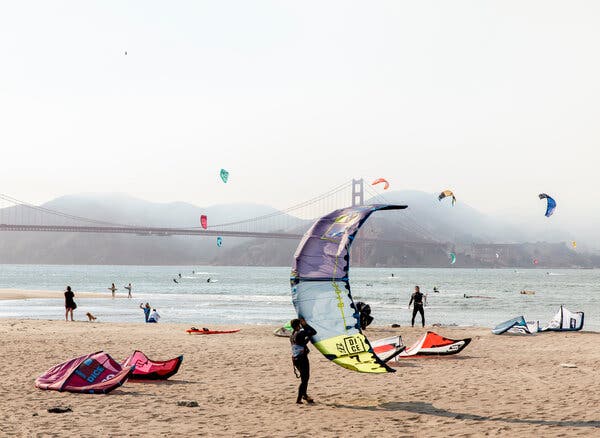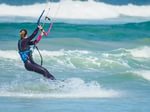SAN FRANCISCO — It is the beachfront version of a double black diamond ski slope, smack in the middle of this major American city, framed by the San Francisco skyline and fog-wreathed Golden Gate Bridge. Playing out against this backdrop most weekdays in summer is a scene so hair-raising as to seem unreal: dozens of board riders pulled by kites across the bay at speeds of up to 40 miles an hour, the boards themselves attached to hydrofoils engineered to lift them above the surface, making it seem as though the riders are suspended between water and sky.
For decades, kitesurfers and, more recently, their foilboarding descendants have turned up at Crissy Field, a scruffy crescent of sand at the foot of the historic Presidio of San Francisco.
“Crissy Field is a world-class site,” Jane Cormier said on a recent afternoon chilly enough to justify Mark Twain’s often quoted observation about summer in San Francisco being the coldest winter he’d ever known.

An instructor and owner of a local windsurf shop, Ms. Cormier, 54, is among the regulars at this spot, which routinely draws the most skilled kitesurfers on the planet, both professional athletes and a group of gutsy amateurs that skews heavily to Silicon Valley tech types. They show up when the wind rises, in their customized vans, slick Dodge Sprinters or salt-pitted Jeeps with clamshell cargo boxes bolted to the roof.
And since a resurgence in numbers of the coronavirus sparked the resumption of shutdowns in a city slowly evolving toward something like normalcy — schools, museums, theaters, malls and many shops and restaurants remain shuttered or are limping along at a fraction of capacity — a beach many locals take for granted has provided a front-row seat on what may be the best show in town.
“The lure of the place is obvious,” said Ms. Cormier, her face slathered with sunscreen. “You have this tremendous beauty, and you have the conditions.”
The conditions she was referring to include frigid waters, erratic chop, the enormous container vessels that ply the open shipping lanes, as well as tides that can easily suck the unsuspecting out to sea. Add to these the powerfully gusting winds created by one of those geological anomalies that seem to define California. Here, at the Golden Gate, a break appears in a coastal mountain range that extends unbroken for hundreds of miles; through that portal rushes the cool ocean air of the marine layer as the kiln-like heat of the central valley rises to create a mighty suction most afternoons.
“It’s a Venturi effect, and it needs to be respected,” said Stefaans Viljoen, a Mill Valley tech entrepreneur in his 40s, referring to winds that can propel foilers to racehorse speeds.
“Why do we do it?” Mr. Viljoen asked as he shed his street clothes beneath a surfer’s changing hoodie and then wriggled into a wet suit. “Because we have to. Because it’s an addiction.”
And because, whenever three or more people share an interest, there is a community, thus there exists a fellowship of wind addicts.
“Most people out here have a wind addiction,” Erin Loscocco said as he crouched on a bench checking out the wind on a recent afternoon. Unlike some on the scene, who grew up sailing and graduated first to kitesurfing — and then, as technology evolved and boards improved to include a fuselage and wings on their undersides to raise them off the water, foiling — Mr. Loscocco, 41, came relatively late to the sport. When the wind is up, he drops his job building home theaters to foil at least three times a week. He also runs a Bay Area kiteboard group on Facebook and is developing a plan to foil to the Farallon Islands, 30 cold ocean miles beyond the Golden Gate.
“When I started out, somebody told me, ‘You’ll never look at a flag the same way again,’” Mr. Loscocco said.
Crouched on a sea wall gazing out at the bay, Daniela Moroz, 19, was staying dry one recent afternoon, a rare occurrence for a world champion who took up kitesurfing when she was 12. “Crissy Field is so dramatic, people from all over the world are stoked just to kite here,” Ms. Moroz said.
Part of the attraction is falling in among the elite athletes who treat Crissy Field as their backyard, among them the siblings Johnny and Erika Heineken, each a two-time world champion in the sport, and others like Bill Bergerson, known as Peewee, a storied surfer whose exploits thread through “Barbarian Days,” William Finnegan’s Pulitzer Prize-winning memoir.
“It’s a cool little community of really connected kiters,” said Ms. Moroz, who was named a Rolex yachtswoman of the year while still in high school. “The thing is, if you can sail here, you can sail anywhere. It’s a bit more of an extreme sport, and a lot can go wrong.”
Danger is substantially what makes for such compelling viewing. Beautiful as it is to see the horizon dotted with colored kites zigzagging across the bay, the thrill is watching the best and most intrepid riders rocket off the surface as they catch big air. Unlike some of the 30 or so other kite-launching spots around the Bay Area, the waters off Crissy Field are cruelly unforgiving. “This may be the most rescued place on the planet,’’ Ms. Cormier said, referring to the cruisers from the nearby Coast Guard Golden Gate station that routinely pluck stranded kitesurfers out of the bay.
“Check this out,” Paul Heineken said, as he opened his smartphone to demonstrate a GPS diagram of his son Johnny’s progress across the bay that afternoon. A series of route lines generated by the phone that, like most foilers, Johnny Heineken, 32, wears in a waterproof pouch tucked beneath his wet suit, crossed and intersected in jagged scribbles.
“Thirty-five miles in two hours at an average of 15 knots,” said Mr. Heineken, 74, who is a physician, active windsurfer and former commodore of the nearby St. Francis Yacht Club. “Though he hit 41 knots in a couple of places,” he added with a laugh.
With the wind up, a cluster of foilers — Laurent Detoc, 53, a gaming company executive; Joshua Waldman, 38, a yacht captain; Ms. Cormier, the sailing instructor — clad in seal-like neoprene wet suits, hoods, flotation belts and helmets crab-walked with their wind-filled kites across the narrow beach and waded into the water. Within an eye blink, they were up on their boards and tearing out of sight.
“All these wind sports are highly individual, and they produce a Zen-like experience,” said Felix Louis-Njai, a Crissy Field regular, adding that this particular form of Zen is poorly suited to the risk-averse. Notably one of the few people of color pursuing what is inarguably a white-dominated sport, the 40ish tech entrepreneur had painted a Black Lives Matter logo across his sail.
“It would be disingenuous if I didn’t do that since there are not a lot of people out here that look like me,” Mr. Louis-Njai said.
And the numbers are not large of those anywhere with the guts to embrace a pursuit that Mr. Heineken, the world champion, called sailing in its purest form — just a board, a kite and a human channeling the elements.
“As a sport, this can be scary as hell,” said Michael Vestel, a scientist in his 50s who works as chief technology officer at a start-up, one afternoon in the Crissy Field parking lot. Casually stripping off his street clothes, Mr. Vestel suited up in a sandy quadrangle overflowing with pumps, boards, sails and a passel of ever-present dogs.
“If you don’t know the tides or gauge your skill level correctly, scary things can happen,” he said.
Misjudge the tides, the wind or your own acumen and you can find yourself inadvertently shooting the gate — the term for flying between the Golden Gate towers and toward open ocean — and on your way to Japan, he said. Merely to contemplate that unwelcome prospect is enough to produce a jolt of adrenaline. And that is not always a bad thing, at least not when the rush it produces momentarily blots out thoughts of a grinding pandemic and of the wildfires that continue to smudge the air over San Francisco a smutty brown.
“One great thing is that, despite the virus, they never stopped our water access,” said Michael Gilbreath, 48, a nurse at U.C.S.F. Medical Center. Given a rare afternoon off, Mr. Gilbreath had reflexively packed up his foiling gear and headed to Crissy Field. “All through this thing,” he said, “they never closed our church.”





Recent Comments